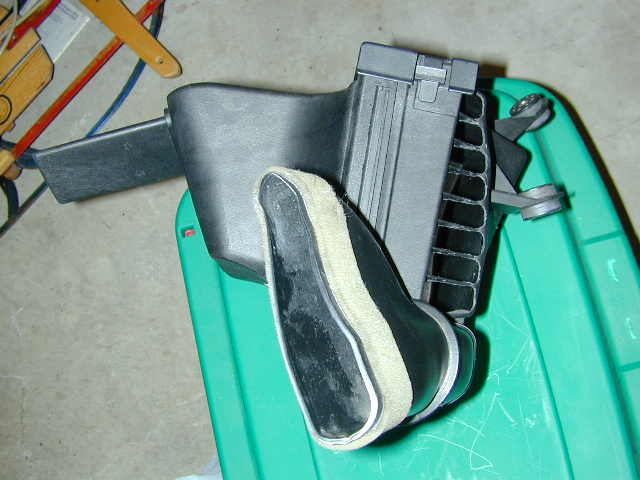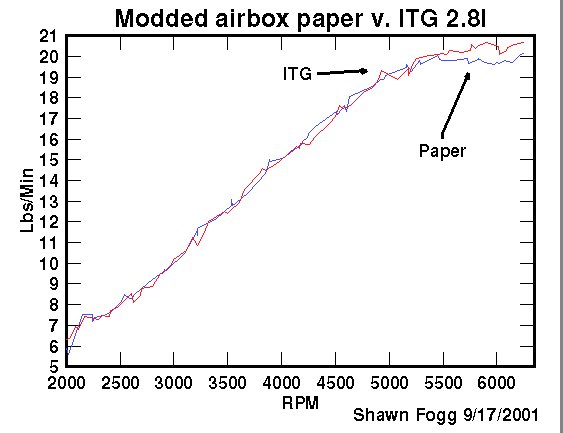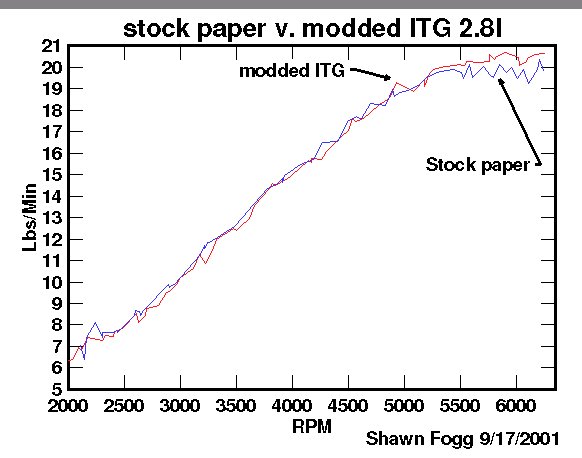
BMW had two basic versions of the airboxs in the 2.8l cars. There is an early box and a later airbox. It appears they made the change in 9/98 production.
For later 2.8l airboxes Nathan Fong has a mod here. I haven't tested it but it does look to be well done.
For the early style airbox I have an airbox modded the design is different from the 1.9l Fogged airbox. I about double the surface area for airflow into the box and get better distribution to the filter.

Basically I open up the leading edge of the box between the reinforcing spars on the front of the airbox. By the way the airbox sits in the car I hope that the protrusion holding the filter will act as a shield to keep hot air out of the intake.

Finally, thanks to Joe Maienza stopping by, I have tested the airbox! Joe has a 6/98 production 1998 Z3 2.8l with a SuperSprint exhaust. The chart below shows airflow of his car with his stock airbox in place and with the Fogged airbox in place. The air temp during the six second gear runs on the stock airbox was 55 degrees according to his OBC. My temperature sensor in the airbox itself was showing 65 degrees. When we tested the Fogged airbox the temperature was 59 degrees on the OBC and 69 degrees inside the box itself during the 7 second gear runs. 10 degree difference in both cases so it does not appear that radiator heated air is a problem with the setup. A new paper filter was installed for both runs.

We tested from 1000 rpm to about 6300 rpm about 400 rpm shy of the limiter. Below 3000 rpm the airflow was identical so I didn't show it on the graph. In the above graph the dots are the actual data points and the lines just connect them. At just over 4k for example it looks like the Fogged lost airflow compared to stock but there isn't any data points for stock in that area so we can't be sure. The numbers made some what large changes based on small RPM changes in that region so I'm wondering if VANOS was changing there? Additionally, I screwed up and forgot to disable ASC+T on the car so it is possible that may have influenced the numbers if that had kicked in during the runs. It was a dry day on a clean road so this is unlikely to have occurred.
I have not yet crunched all the volumetric efficiency numbers (will update this when I do) but it looks like up high VE increased about 3% with the Fogged airbox. With the Fogged 1.9ls I've seen increases from 3% to about 8.5% depending upon the car. I'm thinking about further modifying the 2.8l airbox by removing some of the spars to make the new intake area more continuous which should further reduce the restrictions into the box. This may or may not improve the airflow increase seen above though... won't know till it is tested. Shouldn't hurt though. Also, do not know what we would see above 6300 rpm.
To be sure this wasn't causing any problems with the car we used a R5-FCX to check the DME for faults we started and after the runs were complete. No faults were in the DME.
David Pavlik has a '97 2.8l and made another version of a cold air intake for his car. His design is here.
We met up to try testing his design out against stock with a new paper filter. We also tested the paper filter vs. and ITG foam filter. The rest of his induction and exhaust system were stock. Intake air temp for all runs was about 75 degrees. I wired up a temporary shift light set at 6200 rpm. This helps give a more consistent top end measuring point. Basically we floor it in second gear and don't lift till the shift light turns on. We made 5 runs in each configuration.
First up is stock vs. modded with factory new paper filter.

Doesn't appear that the intake made much of a difference either way. The modded flow numbers were a little smoother then stock but the air mass between the two is very similar.
Second is comparing paper vs. ITG with the modded airbox.

Here the ITG looks like it helped on the top end.
For a comparison here is the modded airbox with the ITG vs stock airbox with the paper filter.

Unfortunately, we didn't compare the paper vs. ITG in the stock airbox. I'd also like to try his mod but not having the tube connected to the bottom of the car in case the air moving over the inlet (from the forward motion of the car) is lower pressure (Bernoulli's law) then at the top of the tube and is effecting flow. Also a comparison of my above mod vs. David's on the same car would be interesting to see. Unfortunately there are not enough hours in the day.
BTW, we also had a K&N replacement panel filter to test but the
fit of it in the airbox cartridge was very lousy. Neither David or myself
trusted it enough to even test it in that manor. The ITG fit the cartridge
well.
In the Siemens DME there is a condition where any CAI can cause a check engine light. It is because the DME tries to calculate the temperature of the catalytic converter and if it thinks it gets to hot it takes action to prevent damage. It calculates the temperature based on load, RPM and time mostly. Load is calculated from potential airflow vs. actual airflow (very much like Volumetric efficiency)... it tells the DME how hard the engine is working. If you add a CAI (or increase airflow beyond stock) it can change the load slightly at WOT since the actual airflow has increased. The Siemens engineers that programmed the DME did not take into effect what happens when an intake is added to the car. If the engine spends a lot of time at high RPM, high load conditions (like WOT on the track), on a hot day, and experiences a little timing retard due to knock the DMEs calculations can make it think the catalytic converter temperature is to hot. This will make the DME run the engine very rich, to cool the cat., and it can trigger a fault for this. This is very rare but might be a slight concern if you tracked your car.
Jim C.'s old 'Intake' software corrected for this. The only thing that was different between his intake and non-intake software was he changed around the catalytic temperature calculations. The air/fuel maps were identical... in fact a car with the stock airbox would run **perfectly** fine with the 'intake' version of his software. To the point that with the release of the Shark Injector they ALL ship with the 'intake' version of his software.
As best I can determine this is not the case with Dinan's "Stage II" software. They require Stage II on 1.9ls which use Bosch DMEs which don't have the catalytic converter protection routines. On 2.8ls some require the "Stage II" some don't. But all 2.8ls use Siemens DMEs and have the cat. protection routines in there. Also, if it was the cat. protection stuff in "'Stage II" they could just have put that in "Stage I" and only had one version of software like Jim C. did with the Shark Injectors.
On the street this problem is a non-issue. On the track it is still only a small concern but worth mentioning. Running high octane fuel to help avoid knock would also help to avoid this problem when you are tracking the car.